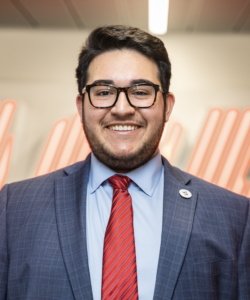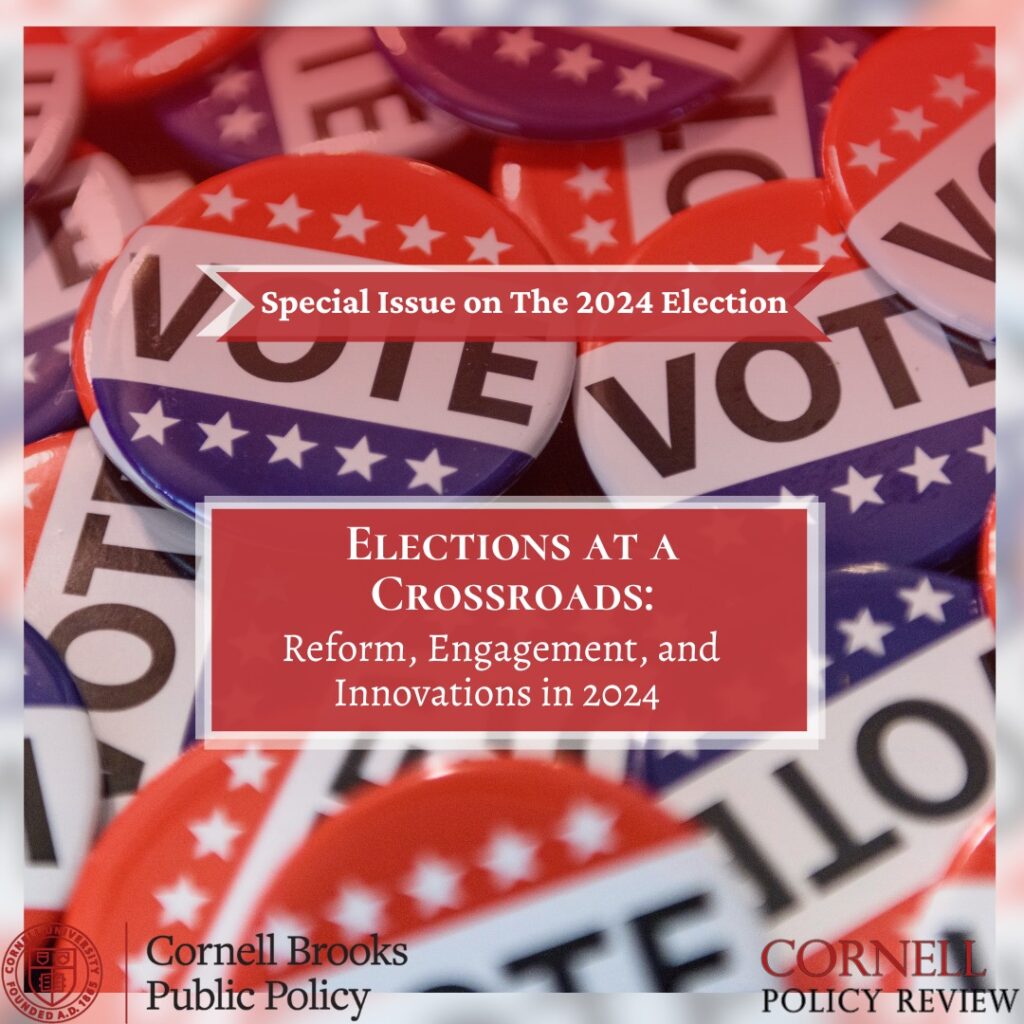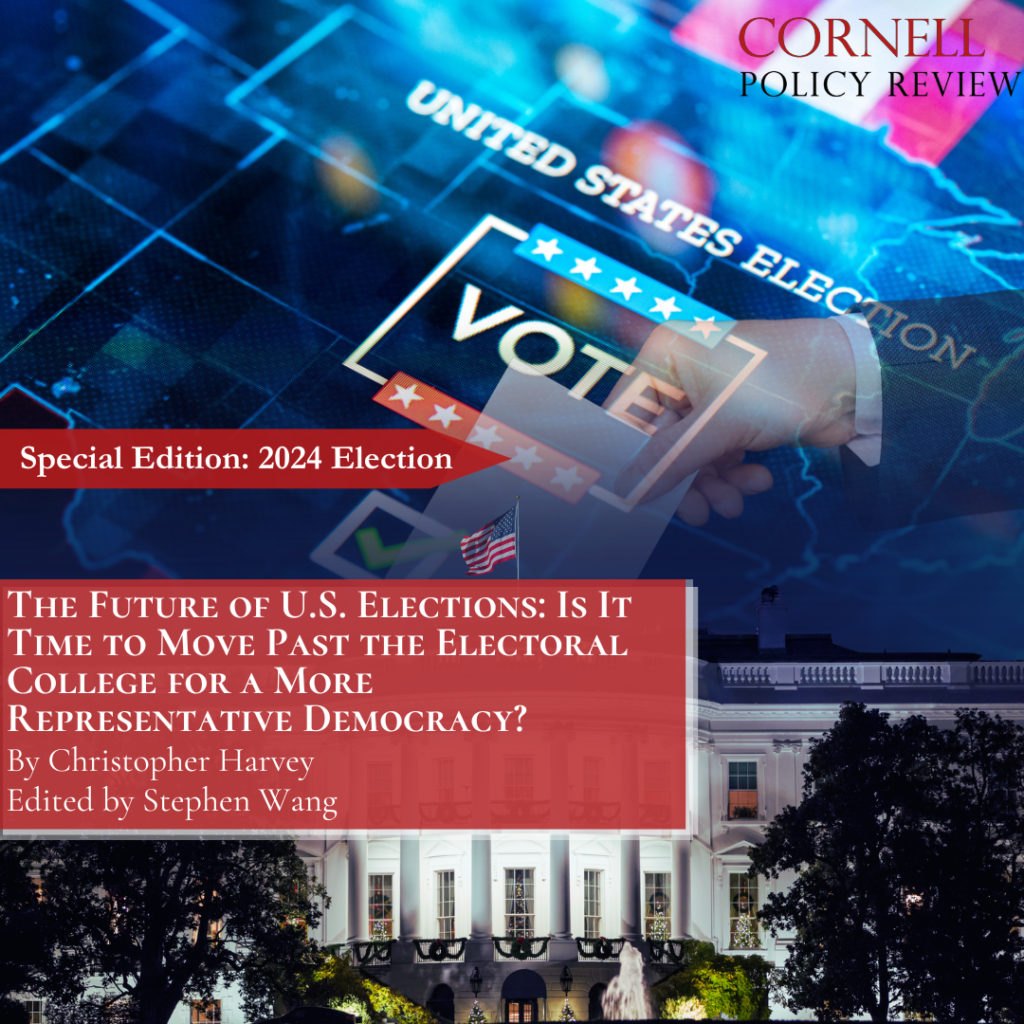By: Alejandro J. Ramos and Theodora Curtain
Edited by: Maddie Miele
Graphic by: Henry Deng
Introduction
Youth voters represent a growing and increasingly influential demographic in U.S. elections, yet they consistently vote at lower rates than older generations. The “youth vote” is defined as voters between the ages of eighteen to twenty-four, encapsulating voters in Generation Z. Voter turnout is defined as the percentage of voters who participated in voting compared to the proportion of eligible voters who did not. While the 2020 election saw a spike in youth voter turnout, the numbers remain below their potential. An estimated 50 percent of young voters, ages eighteen to twenty-nine, participated in the 2020 presidential election, an eleven-point increase from 2016 when only 39 percent of youth voters turned out.1 In comparison, the voter turnout was highest among those ages sixty-five to seventy-four at 76 percent.2 This is likely one of the highest rates of youth electoral participation since the voting age was lowered to eighteen.3 This trend is particularly concerning as young people will face the long-term consequences of policy decisions made today. One of the key factors influencing youth voter engagement is the level of civic education they receive. Civic education not only teaches students about the mechanics of government but also instills in them the importance of participating in the democratic process.4
However, civic education programs in the United States vary widely across states, leaving many young voters underprepared to engage in elections. Some states have robust programs that emphasize real-world democratic participation, while others offer minimal instruction, if any. As the 2024 election approaches, the need for stronger, more consistent civic education has become evident. Addressing these gaps is critical to increasing youth voter turnout and ensuring that young voters are equipped to shape the future of American democracy.5 This article explores the connection between civic education and youth voter turnout, examines the barriers to engagement, and proposes policy solutions to better prepare the next generation of voters for the 2024 election and beyond.
Problem Section
While youth voter turnout is slowly increasing across the United States, there are major discrepancies in turnout rates from state to state. Michigan, Maine, Minnesota, Oregon, Colorado, and Pennsylvania saw the highest youth turnout rates in the country during the 2022 midterm elections. Louisiana, Oklahoma, Indiana, Alabama, Tennessee, and West Virginia experienced the lowest voter turnout.6 Regional trends show that the southern United States tends to have the lowest youth voter turnout, while the Northeast, Midwest, and West Coast differ only marginally.
These regional differences can be attributed to the uneven nature of civic education programs. The same states with the lowest youth voter turnout tend to spend the least on education.7 Federal programs, like “No Child Behind,” that could supplement this deficit in local funding largely neglect civic education programs.8 On the other hand, youth voter turnout trends have shown that states that prioritize civic courses have the highest rates of youth civic engagement.9
Besides the variation in funding, civic education standards differ greatly across states. Only nine states and the District of Columbia require one or more years of civic education, thirty states require half a year, and eleven have no requirements for civics classes at all.10 This leaves significant gaps in voter preparedness that vary from state to state. Closing these gaps is critical to our democracy. The difference in youth voter turnout in states with supported civic programs and states without clearly reflects the positive correlation between youth voter turnout and the prioritization of proper civics programs. Thus, to increase the youth vote civic education programs across the United States must be equally implemented, funded, and prioritized.
Current Programs
Prioritizing civic engagement means providing civic education with more funding, adopting programs that establish standardized curriculums and benchmarks for achievement, and applying topics in class to experiential learning. One such program that hits all of these goals is “Project Citizen.” Project Citizen programming, housed under The Center for Civic Education (CivicEd), has had notable strides in this space.11 Dr. Diana Owen, Director of The Civic Education Research Lab (CERL), has partnered with CivicEd to research the effects of the curriculum. This partnership and its projects have received funding from a grant from the U.S. Department of Education.12 Project Citizen is an interdisciplinary curricular program for middle, high school, and post-secondary students that teaches students about government and public policy through hands-on engagement and instructional learning. Student’s experiential learning includes researching a public policy issue in their community and learning how to influence and monitor government legislation related to this policy. The latest research on Project Citizen’s efficacy shows a strong correlation between the strides it has made in civic education and the resulting upward trend in youth turnout rates for its participants. The percentage of high school students who scored as “very likely to turn out” in elections increased by 19 percent over the three-year study period.13
Building on the success of Project Citizen, the State Seal of Civic Engagement in California offers another example of how structured civic programs can foster deeper student involvement. The State Seal of Civic Engagement is awarded to students who “demonstrate excellence in civics education and participation, and an understanding of the United States Constitution, the California Constitution, and the democratic system of government.”14 The seal, implemented in 2020, encourages students to engage in civics on a deeper level, fostering more understanding and interest in the American government. Since the program is so new, there is no current data for its effect on youth turnout rates. However, simply voting is not the only measure of the successful interplay between education and a functioning democracy. For a democracy to be successful, its voters must be knowledgeable. As James Madison wrote, “Knowledge will forever govern ignorance: And a people who mean to be their own Governors, must arm themselves with the power which knowledge gives.”15 In our current political climate, only 47 percent of adult Americans can name the three branches of government, and only 24 percent can name their First Amendment rights, as found by a survey from Penn’s Annenberg Center for Public Policy.16 The survey also found that the only respondents who got all these questions right took civics in high school.17 Thus, these two programs are not only critical to getting young people to the polls, but to ensuring that they know what to do when they are there.
While the success of these programs should be highlighted, it is also important to note some of the challenges that have come with their implementation. Currently already instated civic education programs come with three main obstacles to efficacy: Insufficient and unstandardized curriculums, lack of teacher preparedness, and shortages in funding.18 While Project Citizen has an established curriculum, it is not being implemented nationally, furthering the educational divide between youth with proper civics training and youth without. Standardizing a civics education curriculum is necessary to provide equal information and opportunity to voters, however doing so is increasingly complicated in the current hyper-polarized environment.19 Lawmakers who set the standards for these curriculums vary in their opinion on what the curriculums should include, and how these topics should be taught.20 Even if a standardized curriculum were to be adopted, there is still the chance that it could be improperly taught. The time allotted to practicing teachers for professional training in social studies has been steadily decreasing across the country. Failure to properly teach civics could be as detrimental to the youth vote as not teaching it at all. Finally, a national scale civics education program would require more funding than the current smaller programs like Project Citizen. Implementation could be delayed due to complications in finding the funding for civics education.
Barriers To Engagement
Although the decline in a standard civic education curriculum is a major factor in the low number of youth voters, other factors that have created significant barriers to youth civic engagement must not be overlooked.
Voter suppression laws, such as strict voter ID requirements, have increasingly stifled the youth vote. Three of the same states with the lowest youth voter turnout in 2022 also have the most restrictive voting and registration policies. Tennessee, Alabama, and Oklahoma, which experience turnout rates of 13 percent, 15 percent, and 15 percent, respectively, do not have same-day, automatic, or pre-registration.21 Inversely, three states with some of the highest youth voter turnout in the 2022 midterm elections have conducted vote-by-mail elections since 2014.22 Strict voter ID requirements present a unique challenge to young people’s ability to vote, as college students who go to school out of state may struggle to attain a photo ID in their new residency or register for a mail-in ballot. In 2020, 43 percent of enrolled college students attended an institution outside of their homestate.23 Currently, twenty-five states require or request photo identification at polling locations. Twelve of these twenty-five states do not accept student IDs for voting.24
The youth of today are also facing a unique political climate due to the integration of social media into political discourse. While social media has been shown to engage youth unreached by traditional candidacy and campaign methods, most of its positive effects have been contracted by its direct hand in increasing polarization, voter apathy, and distrust in government institutions and the democratic process.
Social media, unlike traditional news sources, is uncensored and mostly unregulated. However, 54 percent of Americans, and 65 percent of the youth vote get almost all their news from social media.25, 26 The unregulated nature of social media creates two detrimental factors in changes in political behavior: Polarization and misinformation. Without regulation, extremist groups thrive. They are more able to produce and spread propaganda, which in turn, radicalizes a larger percentage of the population.27 This trend is reflected in the rise of political partisanship in the U.S., especially among youth populations. A Stanford study found distrust in the opposing party and in people who do not share similar political ideologies has risen sharply among adolescents.28
Another aspect of the transformation of political discourse through social media is the increase in anti-democratic ideals, such as populism.29 Social media outlets that peddle populist agendas do so by breaking down user’s trust in democracy, selling the idea that current democratic institutions are inherently faulty, coercive, and will cease to exist. This poisonous ideology, which has now become mainstream, explains the rise in citizen’s distrust of the government. In 2024 just 22 percent of Americans say that they trust the government to do the right thing “just about always.”30 A lack of trust in the government creates higher voter apathy, which dissuades and disenfranchises young people from voting.
Multiple Perspectives
Multiple challenges have led to the decrease in youth voter turnout, including the ways social media has shaped the contemporary political environment for mostly young people, voter suppression laws, and the decline of comprehensive and standardized civic education programs in most American schools. These challenges leave us with the question; what can be done to restore the youth vote? Given the complexity and broad reach of each issue, a solution will have to be multifaceted, implemented at a national level, and specifically target youth.
Changing the unregulated culture of social media would take decades of legislation and an invasion into a mostly private sector. Voter suppression laws are still a result of our current democracy and voting system, and while reversing some of them would alleviate some of the problems, it would not create solutions for the ideologies that created and voted for them. Thus, the most effective and efficient solution, that will address both issues, is to create, promote, and adequately fund a national effort to reinstate civics education in schools across the country.
Advocates for civic education programs, such as The Center for Civic Education argue that a robust civic education enhances youth political engagement, trust in the democratic process and democratic institutions, and reduces polarization.31 Thus, civic education programs can tackle most of the unique challenges posed by young people’s current political climate.
However, opponents of such programs raise concerns about the prioritization and funding of civic education over other reforms that aim to increase voter participation. Other strategies include reforms to voter registration,32 enacting protections that enforce the 26th Amendment,33 and the creation of an election holiday.34 The case for reforms to voter registration comes from a case study in Georgia, in which data from the 2016 general election, 2020 general election, and 2021 runoff election were analyzed. The researchers found that a key aspect of increasing civic engagement is to lessen the restrictions around voter registration. Specifically, automatic voter registration was found to be notable in increasing voter turnout. The 26th Amendment gave people aged eighteen the right to vote. However, it does not protect against the unique barriers to voting that young people face. The Civic Center advocates for Congress to solidify the following protections for young people’s right to vote: Voter pre-registration, election-day registration, and the allowance of student IDs in place of other forms of photo identification at polling locations. The creation of an election holiday would close federal buildings during election days, allowing students who would otherwise have been in school to have more time to get to the polls.
Proponents of these programs do not exactly oppose civic education reforms, but more so they believe that other reforms may be necessary as a substitute or in conjunction with these programs. Direct opponents of civic education programs believe that efforts to reform or reinstate civic education is a guise to left-wing radicalization.35 They argue that these programs would serve certain ideological goals of the democratic party. More specifically, Civics Alliance finds flaws in both Project Citizen and the Seal of Civic Engagement. It argues that programs that focus on “action politics,” “encourage and reward the ideological peer pressure of dogmatic students.” Even when civic education finds bi-partisan support, lawmakers struggle to find a middle-ground for what reforms will look like, and what content these programs will include. Each side fears that these programs could be used to purposefully influence young voters. While more than 75 percent of Democrats support the teaching of societal programs, racism, political issues, and income inequality as a part of civic education, almost less than half of Republicans support teaching the same content.36
Policy Recommendations
Standardizing civic education across the United States is a critical step toward ensuring consistent voter preparedness. A national framework should be developed, encouraging states to adopt comprehensive civic curricula with a focus on experiential learning. Federal and state governments can offer financial incentives to schools that implement such programs, following the examples set by California and nonprofits working across the country. Integrating the Citizenship Empowerment Framework (CEF), developed by Alejandro J. Ramos, which emphasizes civic knowledge, skills development, and fostering civic dispositions, will ensure students are equipped with the tools necessary to navigate societal complexities and participate meaningfully in democratic processes.37 This framework provides a structured guide for educators and policymakers to design inclusive and impactful civic curricula tailored to the needs of diverse student populations.38 To successfully implement CEF, teacher preparedness must be prioritized through targeted professional development programs.
Beyond improving education, policies must facilitate greater access to voting through pre-registration programs and same-day registration options. Introducing pre-registration in high schools would engage students early, fostering familiarity with the voting process before they reach voting age. Offering same-day registration can reduce administrative barriers, ensuring more young people have the opportunity to participate in elections. Additionally, election-day education activities, such as mock elections, can reinforce the importance of electoral participation and demystify the voting experience for first-time voters.
In today’s political environment, technology and social media play a pivotal role in engaging youth. Policymakers and civic organizations should partner with social media platforms and influencers to promote civic awareness and combat misinformation. Developing interactive online tools, such as voter guides and educational quizzes, will make election-related information accessible to younger audiences, many of whom consume political content primarily through digital means. These strategies can enhance youth engagement and empower students to make informed voting decisions.
Structural reforms are also necessary to eliminate barriers to youth participation. Expanding the use of student IDs for voter identification and allowing out-of-state students easier access to mail-in ballots will address challenges faced by college-aged individuals. Advocating for automatic voter registration and creating national election holidays will alleviate logistical barriers, ensuring young voters have the time and resources to engage fully in the democratic process.
Finally, civic engagement programs like Project Citizen and the State Seal of Civic Engagement should be promoted across educational levels to foster hands-on learning. Investments in professional development for educators are essential to ensure teachers are well-prepared to implement innovative methodologies. Aligning civic education initiatives with the principles outlined in the Citizenship Empowerment Framework will create a generation of informed, engaged, and responsible citizens capable of contributing to the resilience of democratic institutions.
Conclusion
Youth voters hold the power to shape the future of American democracy, yet their turnout remains significantly lower than that of older generations. Strengthening civic education through the adoption of comprehensive frameworks, such as the Citizenship Empowerment Framework, is essential to preparing young people for meaningful participation in elections.39 Standardizing curricula, promoting voter access through reforms like pre-registration, and leveraging technology will empower youth to engage confidently in democratic processes.
The 2024 election provides an opportunity to prioritize these reforms and ensure young voices are heard at the polls. Policymakers, educators, and civic organizations must collaborate to create lasting solutions that promote civic responsibility and increase voter turnout. Investing in youth engagement today will not only enhance voter participation but also ensure the resilience of democratic institutions for generations to come. With the right policies, young voters can become a driving force in shaping a more inclusive and vibrant democracy. By prioritizing civic education today, we can empower the leaders of tomorrow and safeguard the future of our democracy.
Addendum—Overall Youth Turnout in 2024 Down From 2020
(Written November 14, 2024; three weeks after article submission)
As of November 6, 5:00pm EST, it is estimated that 42 percent of young voters cast ballots in the 2024 presidential election, a lower youth turnout then 2020 when estimates were above 50 percent—but approximately on par with the 2016 presidential election.40 According to the Center for Information Research on Civic Learning and Engagement (CIRCLE), Young voters cast 14 percent of all ballots in the 2024 election, according to the National Election Pool exit poll conducted by Edison Research. While this number may be adjusted in the coming days, and other data sources may show different numbers, this 2024 youth share of the vote was also lower than in 2020 (17 percent) and to 2016 (19 percent) based on the same data source.
Works Cited
1. CIRCLE. 2021. Half of Youth Voted in 2020, An 11-Point Increase from 2016. April 29. https://circle.tufts.edu/latest-research/half-youth-voted-2020-11-point-increase-2016.
2. The US Census Bureau. 2021. 2020 Presidential Election Voting and Registration Tables Now Available. April 29. https://www.census.gov/newsroom/press-releases/2021/2020-presidential-election-voting-and-registration-tables-now-available.html.
3. CIRCLE. 2021. Half of Youth Voted in 2020, An 11-Point Increase from 2016.
4. Ramos, Alejandro J., interview by Norie Wright. 2024. Feeding the Flame: Discussing America’s Need for Civic Education (May).
5. Bhalekar, Aarul. 2024. Empowering Youth for Greater Civic Engagement: Building Inclusive, Responsive, and Resilient Democracies. October 3. https://yourcommonwealth.org/social-development/empowering-youth-for-greater-civic-engagement-building-inclusive-responsive-and-resilient-democracies/.
6. CIRCLE. 2023. State-by-State Youth Voter Turnout Data and the Impact of Election Laws in 2022. April 6. https://circle.tufts.edu/latest-research/state-state-youth-voter-turnout-data-and-impact-election-laws-2022.
7. World Population Review. 2024. Per Pupil Spending by State 2024. https://worldpopulationreview.com/state-rankings/per-pupil-spending-by-state.
8. Educating for American Democracy Initiative. 2021. “Excellence in History and Civics for All Learners.” Educating for American Democracy. March 2. https://www.educatingforamericandemocracy.org/wp-content/uploads/2021/02/Educating-for-American-Democracy-Report-Excellence-in-History-and-Civics-for-All-Learners.pdf.
9. Shapiro, Sarah, and Catherine Brown. 2018. A Look at Civics Education in the United States . https://www.aft.org/ae/summer2018/shapiro_brown#:~:text=Key%20Findings,states%20have%20no%20civics%20requirement.
10. CIRCLE. 2012. State Laws, Standards, and Requirements for K-12 Civics. October 16. https://circle.tufts.edu/latest-research/state-laws-standards-and-requirements-k-12-civics.
11. The Center for Civic Education. 2024. Project Citizen. https://www.civiced.org/project-citizen.
12. The Georgetown University Communication, Culture, & Technology Program. 2024. CCT Professor Highlight: Diana Owen. https://cct.georgetown.edu/announcements/cct-professor-highlight-diana-owen/.
13. The Project Citizen Research Program. 2024. Project Citizen Research Program. https://www.civiced.org/project-citizen/pcrp.
14. California Department of Education. 2024. State Seal of Civic Engagement. June 20. https://www.cde.ca.gov/ci/pl/hssstateseal.asp.
15. Madison, James. 1822. “James Madison to W. T. Barry.” Library of Congress. August 4. https://www.loc.gov/resource/mjm.20_0155_0159/?sp=1&st=text.
16. Patel Shepelavy, Roxanne. 2022. Ideas We Should Steal: State Seal of Civic Engagement. September 27. https://thephiladelphiacitizen.org/state-seal-civic-engagement/.
17. The Annenberg Public Policy Center of the University of Pennsylvania. 2022. Americans’ Civics Knowledge Drops on First Amendment and Branches of Government. September 13. https://www.annenbergpublicpolicycenter.org/americans-civics-knowledge-drops-on-first-amendment-and-branches-of-government/.
18. Fry, Sara Winstead, and Adil Bentahar. 2013. “Student Attitudes Towards and Impressions of Project Citizen.” Journal of Social Studies Education Research 1-23.
19. The Edmond J. Safra Center for Ethics at Harvard University. 2021. A New Roadmap for 21st Century History And Civic Education. March 2. https://ethics.harvard.edu/Educating-American-Democracy-Roadmap.
20. Hess, Rick. 2021. Tackling Polarization Via a ‘Cross-Partisan’ Approach to Civics Education. December 16. https://www.edweek.org/teaching-learning/opinion-tackling-polarization-via-a-cross-partisan-approach-to-civics-education/2021/12.
21. Hilton, Katie, and Alberto Medina. 2024. Changes to Election Laws May Affect Youth Voting in 2024. August 14. https://circle.tufts.edu/latest-research/changes-election-laws-may-affect-youth-voting-2024.
22. Ibid.
23. Ethier, Marc. 2021. On The Move: New Study Shows More Students Leaving Home For College. August 20. https://poetsandquantsforundergrads.com/news/on-the-move-new-study-shows-more-students-leaving-home-for-college/#:~:text=The%20resulting%20data%20shows%20that,home%20state%20to%20attend%20college.
24. League of Women Voters of the United States (LWVUS). 2024. Challenges Facing Student Voters. June 20. https://www.lwv.org/blog/challenges-facing-student-voters.
25. Pew Research Center. 2024. Social Media and News Fact Sheet. September 17. https://www.pewresearch.org/journalism/fact-sheet/social-media-and-news-fact-sheet/?tabItem=61d3b974-9b3e-4bdf-a247-064a3080c418.
26. Deloitte. 2021. Are younger generations moving away from traditional news sources? https://www2.deloitte.com/se/sv/pages/technology-media-and-telecommunications/topics/digital-consumer-trends/are-younger-generations-moving-away-from-traditional-news-sources.html.
27. Olaniran, Bolane, and Indi Williams. 2020. “Social Media Effects: Hijacking Democracy and Civility in Civic Engagement.” Platforms, Protests, and the Challenge of Networked Democracy 77–94.
28. TYLER, MATTHEW, and SHANTO IYENGAR. 2023. “Learning to Dislike Your Opponents: Political Socialization in the Era of Polarization.” American Political Science Review 347–54.
29. Olaniran, Bolane, and Indi Williams. 2020. “Social Media Effects: Hijacking Democracy and Civility in Civic Engagement.”
30. Pew Research Center. 2024. Social Media and News Fact Sheet. September 17. https://www.pewresearch.org/journalism/fact-sheet/social-media-and-news-fact-sheet/?tabItem=61d3b974-9b3e-4bdf-a247-064a3080c418.
31. The Center for Civic Education. n.d. Advocacy. Accessed October 2024. https://www.civiced.org/advocacy.
32. Ibreak, Yousef. 2021. “Youth Voter Engagement: Developing Strategies to Sustainably Increase Youth Voter Turnout.” The Ash Center for Democratic Governance and Innovation. April 6. https://ash.harvard.edu/wp-content/uploads/2021/05/ibreak_pae_final96.pdf.
33. Brill, Laura. 2024. New Report Explains How States Can Support Youth Participation and Strengthen Young Voter Turnout. January 17. https://www.thecivicscenter.org/blog/report-strengthen-young-voters-turnout.
34. Eustice, Kristi, Alison Cook-Davis, Benedikt Springer, and Kelli Brown. 2021. ““There are issues that I care about” What drives civically engaged student voters.” Morrison Institute for Public Policy at Arizona State University. August. https://morrisoninstitute.asu.edu/sites/default/files/vox_populi_2021.pdf.
35. Sailer, John. 2021. The Problems with Left-Wing Alternatives to Civics Education. July 6. https://civicsalliance.org/the-problems-with-left-wing-alternatives-to-civics-education/.
36. Saavedra, Anna. 2021. While Politicians Fight Over Civic Education, Most Parents and Adults Agree on the Subject. June 18. https://healthpolicy.usc.edu/evidence-base/while-politicians-fight-over-civic-education-most-parents-and-adults-agree-on-the-subject/.
37. Ramos, Alejandro J. 2024. Igniting Democracy: America’s Burning Need for Civic Education. February 29. https://www.cornellpolicyreview.com/igniting-democracy-americas-burning-need-for-civic-education/.
38. Ibid.
39. Ibid.
40. CIRCLE. 2024. Overall Youth Turnout Down From 2020 But Strong in Battleground States. November 7. https://circle.tufts.edu/latest-research/overall-youth-turnout-down-2020-strong-battleground-states.
Author Bios
Alejandro J. Ramos is an MPA candidate and Brooks Public Policy Fellow at the Cornell Brooks School of Public Policy. His research focuses on civics, democracy, media literacy, and education policy. At the time of this special edition’s publication, Ramos serves as an Inaugural Graduate Fellow at the Brooks Center on Global Democracy and as a Strategic Research Advisor at DemoLab, where he evaluates civic education programs in Costa Rica.
Theodora Curtin, a first-year undergraduate student, is pursuing a B.S. in Public Policy at the Cornell Brooks School of Public Policy. She is interested in pro-democracy issues including civil rights, civics, education equality, and the role of foundational documents like the constitution in democratic development. Curtin serves as a democracy fellow at the Brooks Center on Global Democracy, where she explores constitutional reforms in West Africa and their effect on the current state of democracy in these countries.




